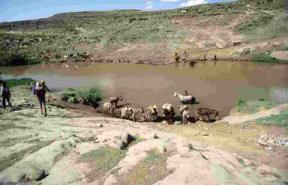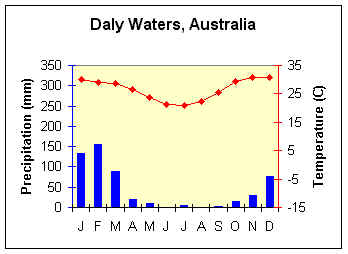Tropical Steppe Climate
The tropical steppe climate is a transitional climate between the tropical wet and tropical dry climates. The controlling factors of the climate are similar to that of the tropical dry climate, though temperatures are cooler and annual precipitation is higher. This is why we consider a steppe climate semi-arid rather than arid.
Geographical LocationThe tropical steppe climate is located on the periphery of deserts. Tropical steppe climate is found bordering the Great Australian desert, the Sahara of northern Africa, and in southwest Asia.
Controlling FactorsThe climate of the tropical steppe is a direct result of its interior continental location and proximity to the subtropical high. The tropical steppe is not as dry as the tropical desert climate as it lies closer to a source of moisture. If on the equatorward side of the desert it is the ITCZ, or the subpolar low and midlatitude cyclones if it is located poleward side. Distinguishing CharacteristicsTemperatureUnlike the midlatitude climates where we mark our seasons by the change from warm temperatures to cold, in the tropical dry climates seasons are distinguished on the basis of it being warm and excessively warm. The generally cloudless conditions that exist in the tropical steppe allows much insolation in to warm the surface. The very high temperatures are also due to the proximity of the climate to cT and mT air mass source regions. Mean annual temperature in the tropical steppe climate is approximately 20oC (68oF). Being located poleward of the tropical wet climates, the annual temperature range increases as the variation in sun angle increases at these locations. Annual temperature ranges vary from 10oC (5.6oF) to above 20oC (11oF). Daily temperature ranges are nearly similar to, or larger than, the annual range of temperature. PrecipitationThe tropical steppe climate is a semi-arid environment. To climatologists, a semi-arid environment can be defined as one where the annual potential evapotranspiration is more than half but less than the total annual precipitation. Potential evapotranspiration is a measure of the demand for water on account of plant transpiration and surface evaporation. In the tropical steppe, much evaporation and plant transpiration would take place if water were available. Meager amounts of precipitation during the relatively long summer droughts stress plants that require water during periods of high temperature. However, during the wet portions of the year, ample precipitation to meet the needs of the natural vegetation usually occurs. Recall that the steppe climate is a transitional climate between truly wet and truly dry climates. The seasonality of precipitation is similar to that of the closest humid climate. For example, the steppe climate found between the tropical desert and wet/dry tropical climate of Africa has a high sun wet - low sun dry seasonality to its precipitation. During the low sun period the subtropical high migrates into this region and suppresses convection. The subsiding air lowers the relative humidity making it difficult to bring air to its saturation point. Life sustaining rains come with the movement of the ITCZ into the tropical steppe. However, the tropical steppe located between the tropical desert and the dry summer subtropical (Mediterranean) climate is just the opposite, high sun dry - low sun wet. During the high sun season the tropical steppe is dominated by the subtropical high. During the low sun season cyclones associated with the subpolar low and polar front dominate. Some regions having a tropical steppe climate are found on the lee side of mountains. As air ascends the windward slopes, water vapor condenses and precipitation occurs. Places located on the leeward side are thus in the "rain shadow" and are dry.
|
 Figure 9.9 Tropical steppe of Ethiopia
Figure 9.9 Tropical steppe of Ethiopia
